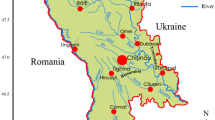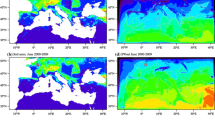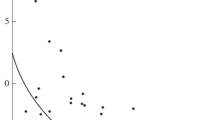Summary
The effects on the hydrological cycle observed with cloud seeding and concentration of land water for public, industrial and agricultural use are discussed. The further consequences and probable results of these activities on weather and climate are analyzed so as to invite attention to and initiate researches of a precipitation augmentation possibility not widely considered at present. The conclusion is that current practices interfere with natural processes in some way while much partial information already point to a more rational procedure for precipitation initiation than cloud seeding. Increased precipitation could be achieved by intensification of local hydrologic cycles modifying the soil surfaces and evaporating waste water from those surfaces. An obvious but actually neglected effect of air pollutants should be taken into account when making preparations for precipitation initiation because they may cause a daily variation of the state of the troposphere in some cases.
Zusammenfassung
Die Wirkungen von Wolkenimpfung und Konzentrierung von Süßwasser für die Verwendung auf öffentlichem, industriellem und landwirtschaftlichem Gebiet auf den hydrologischen Kreislauf werden besprochen. Die weiteren Folgen und vermutlichen Ergebnisse solcher Maßnahmen auf Wetter und Klima werden analysiert, um die Aufmerksamkeit auf eine Möglichkeit der Niederschlagsvermehrung zu lenken, die derzeit noch nicht weitgehend in Betracht gezogen wird, und um zu Forschungen auf diesem Gebiete anzuregen. Es wird der Schluß gezogen, daß die derzeitige Praxis einigermaßen in Widerspruch zu dem natürlichen Vorgang steht, während viele Teilerkenntnisse bereits auf ein rationelleres Verfahren als die Wolkenimpfung für eine Vermehrung der Niederschläge hinweisen. Erhöhter Niederschlag könnte durch die Intensivierung örtlicher hydrologischer Kreisläufe durch eine Modifizierung der Bodenoberfläche und der Verdunstung des Abwassers aus diesen Flächen erreicht werden. Eine offensichtliche, jedoch einstweilen unbeachtet gebliebene Wirkung von luftverunreinigenden Elementen sollte bei der Durchführung von Maßnahmen zur Auslösung von Niederschlägen in Betracht gezogen werden, da diese manchmal eine im Laufe des Tages eintretende Änderung im Zustand der Troposphäre bewirken können.
Similar content being viewed by others
References
Adderly, E. E.: Rainfall Increases Downwind from Cloud Seeding Projects in Australia. Proc. First National Conference on Weather Modification, Albany, 1968.
Brown, K. J., andR. D. Elliot: Larger Scale Dynamic Effects of Cloud Seeding. Proc. First National Conference on Weather Modification, Albany, 1968.
Bryson, R. A.: Possibilities of Major Climate Modification and their Implications: Northwest India, a Case for Study. Bull. Americ. Meteorol. Soc. 1967.
Gelboukh, R. M.: Evaporation from Overgrown Reservoirs. Internat. Assoc. Scient. Hydrology, Bulletin4, 5–9 (1963).
Godson, W. L.: The Influence of the Variability of Solar and Terrestrial Radiation on Climatic Conditions. Proc. Changes of Climate. Rome Symposium: 323–330, UNESCO, 1963.
Kallós, I.: The Effects of Terrestrial Conditions upon Cloud Formation and Precipitation. Annual Report 1951, Hungarian Meteorological InstituteXIV, 130–136 (1951).
Kallós, I.: The Yearly Variation of the Ground Water Level as a Function of the Meteorological Elements and of the Ground Water Level Deepness. Hidrologiai Kozlony, 1961, No. 2.
Lawrence, E. N.: The Development of Low-level Midday Air Temperature Inversions. Meteorol. Magazine,97, 270–277 (1968).
Mitchell, J. M.: On the World-wide Pattern of Secular Temperature Change. Proc. Rome Symposium: Changes of Climate, 161–180, UNESCO, 1963.
Namias, J.: Surface Atmosphere Interactions as Fundamental Causes of Drought and Other Climatic Fluctuations. Proc. Rome Symposium: Changes of Climate, 345–358, UNESCO, 1963.
Stidd, C. K.: Local Moisture and Precipitations. 48th Annual Meeting of the AAAS in Los Angeles, 1967.
Sutcliffe, R. C.: Water Balance and the General Circulation. Quart. J. Roy. Meteorol. Soc.82, 385–395 (1956).
Taubenfeld, H. J., andR. F. Taubenfeld: The Law and Weather Modification. Proc. First National Conference on Weather Modification, Albany, 1968.
Summary of Responses by Federal Agencies, Appendix B: Weather Modification, Laws, Controls, Operations. Report to the Special Commission on Weather Modification, NSF 66-7.
US-Weather Bureau Technical Paper No. 37: Evaporation Maps for the United States.
Author information
Authors and Affiliations
Additional information
With 3 Figures
Rights and permissions
About this article
Cite this article
Kethley, L.I. Weather modification and the hydrologic cycle. Arch. Met. Geoph. Biokl. B. 18, 143–154 (1970). https://doi.org/10.1007/BF02243023
Received:
Issue Date:
DOI: https://doi.org/10.1007/BF02243023




